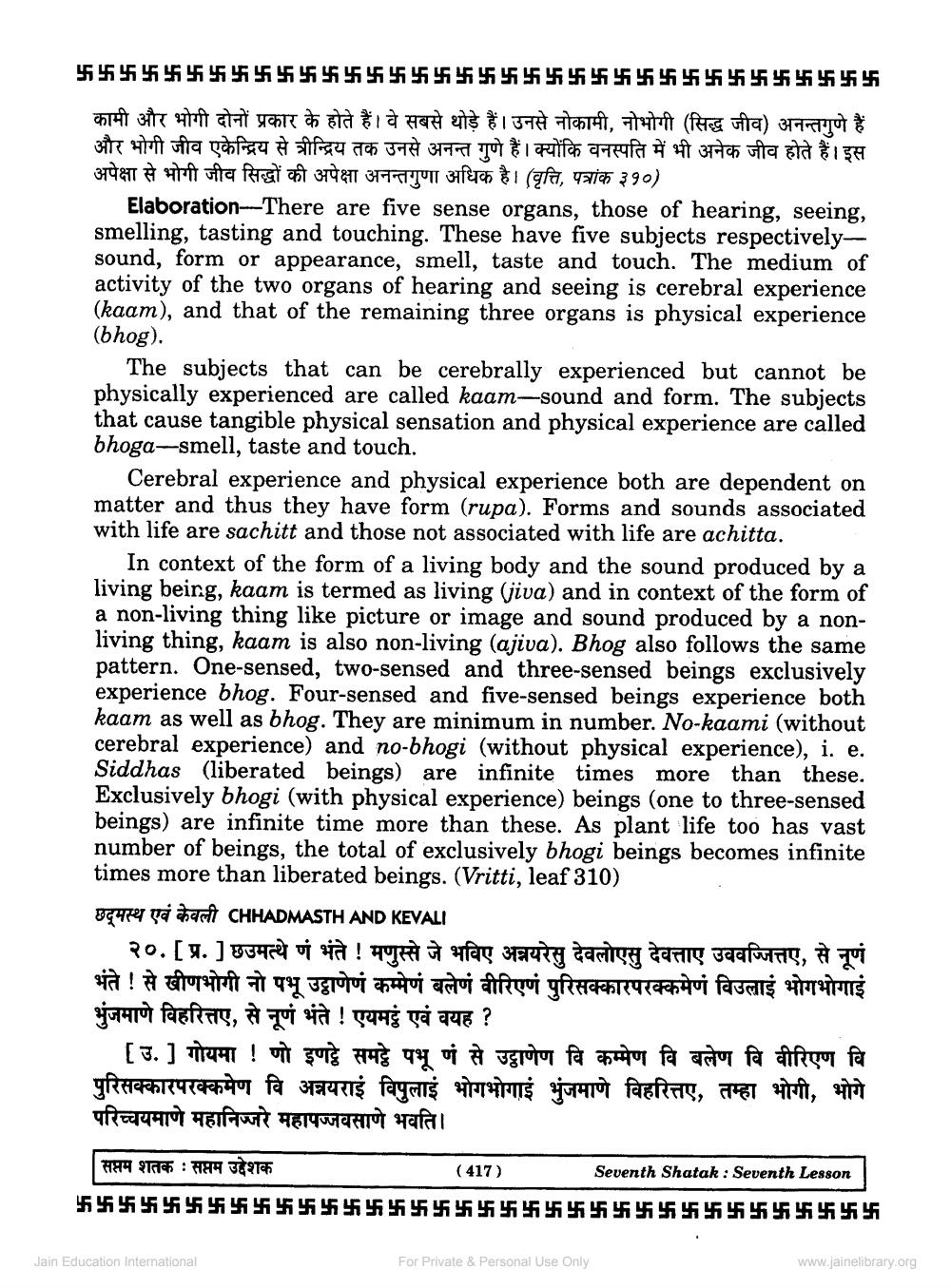________________
தததததத****தமிழதததததததததத************5
कामी और भोगी दोनों प्रकार के होते हैं। वे सबसे थोड़े हैं। उनसे नोकामी, नोभोगी (सिद्ध जीव) अनन्तगुणे हैं। और भोगी जीव एकेन्द्रिय से त्रीन्द्रिय तक उनसे अनन्त गुणे हैं। क्योंकि वनस्पति में भी अनेक जीव होते हैं। इस अपेक्षा से भोगी जीव सिद्धों की अपेक्षा अनन्तगुणा अधिक है। (वृत्ति, पत्रांक ३१०)
Elaboration-There are five sense organs, those of hearing, seeing, smelling, tasting and touching. These have five subjects respectivelysound, form or appearance, smell, taste and touch. The medium of activity of the two organs of hearing and seeing is cerebral experience (kaam), and that of the remaining three organs is physical experience (bhog).
The subjects that can be cerebrally experienced but cannot be physically experienced are called kaam-sound and form. The subjects that cause tangible physical sensation and physical experience are called bhoga-smell, taste and touch.
Cerebral experience and physical experience both are dependent on matter and thus they have form (rupa). Forms and sounds associated with life are sachitt and those not associated with life are achitta.
In context of the form of a living body and the sound produced by a living being, kaam is termed as living (jiva) and in context of the form of a non-living thing like picture or image and sound produced by a nonliving thing, kaam is also non-living (ajiva). Bhog also follows the same pattern. One-sensed, two-sensed and three-sensed beings exclusively experience bhog. Four-sensed and five-sensed beings experience both kaam as well as bhog. They are minimum in number. No-kaami (without cerebral experience) and no-bhogi (without physical experience), i. e. Siddhas (liberated beings) are infinite times more than these. Exclusively bhogi (with physical experience) beings (one to three-sensed beings) are infinite time more than these. As plant life too has vast number of beings, the total of exclusively bhogi beings becomes infinite times more than liberated beings. (Vritti, leaf 310)
छद्मस्थ एवं केवली CHHADMASTH AND KEVALI
२०. [ प्र. ] छउमत्थे णं भंते! मणुस्से जे भविए अन्नयरेसु देवलोएसु देवत्ताए उववज्जित्तए, से नूणं भंते! से खीणभोगी नो पभू उट्ठाणेणं कम्मेणं बलेणं वीरिएणं पुरिसक्कारपरक्कमेणं विउलाई भोग भोगाई भुंजमाणे विहरित्तए, से नूणं भंते ! एयमठ्ठे एवं वयह ?
[ उ. ] गोयमा ! णो इणट्टे समट्ठे पभू णं से उट्ठाणेण वि कम्मेण वि बलेण वि वीरिएण वि पुरिसक्कारपरक्कमेण वि अन्नयराई विपुलाई भोगभोगाई भुंजमाणे विहरित्तए, तम्हा भोगी, भोगे परिच्चयमाणे महानिज्जरे महापज्जवसाणे भवति ।
सप्तम शतक : सप्तम उद्देशक
फ्र
Jain Education International
(417)
For Private & Personal Use Only
Seventh Shatak: Seventh Lesson
www.jainelibrary.org




